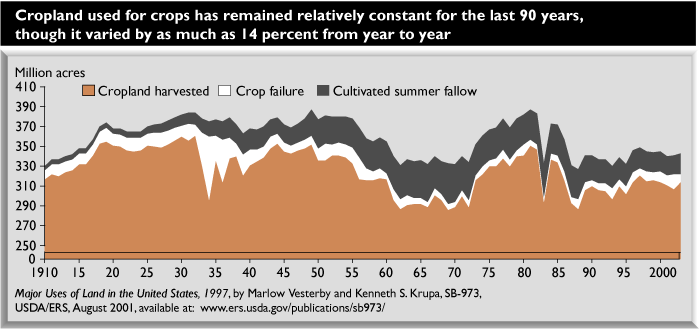Behind the Data
- by Marlow Vesterby and Kenneth S. Krupa
- 11/1/2004
Estimating U.S. Cropland
Measuring cropland area is essential for assessing the economic and environmental performance of U.S. agriculture. ERS tracks cropland in its annual “cropland used for crops” data series, which began in 1910. Cropland used for crops is the sum of cropland harvested, crop failure, and summer fallow. (Total cropland is part of the ERS Major Land Use series, started in 1945, that accounts for all land use in the 50 States.)
The data behind the ERS cropland series come from the Crop Production Annual Summary published by USDA’s National Agricultural Statistics Service (NASS). This survey includes harvested acres of principal crops, the predominant field crops in U.S. agriculture. In 2003, 21 principal crops accounted for about 95 percent of all harvested crop acreage in the United States, but just four crops—corn, soybeans, wheat, and hay—accounted for about 80 percent of all cropland harvested acreage.
The acreages of other crops (fruits and nuts, vegetables, and minor crops), which are published every 5 years by the U.S. Census of Agriculture and change little from one census year to the next, are added to the acres of principal crops to derive total crops harvested. In 2002, “other crops” comprised over 40 other crops plus nursery and greenhouse products. While these crops take up relatively little acreage, they can account for large market value shares of sales.
The Crop Production Annual Summary report counts all acres harvested, including double cropping. However, each cropland acre can only be counted once; thus, double cropping is subtracted from total crops harvested because cropland used for crops becomes part of the ERS Major Land Use series, which must sum to total U.S. land area. The result is total cropland harvested. Most double cropping occurs when soybeans are planted after the harvest of small grains (mainly wheat) in the same year, and these estimates are from the annual NASS acreage report published in June. Smaller acreages of other crops are also double cropped, and these estimates are from the Census of Agriculture.
Crop failure is the difference between cropland planted and cropland harvested. However, some cropland planted is not intended to be harvested. Thus, adjustments are made to account for cover crops, crops grazed, and crops cut for hay. Data for these adjustments are from the Crop Production Annual Summary and the Census.
Cultivated summer fallow occurs predominantly in the Great Plains where it is a practice used to conserve moisture and control weeds. Fields are typically planted and harvested one year and summer fallowed the next. Acreage estimates are obtained from NASS, the Census of Agriculture, or the Conservation Technology Information Center. When no data are available, ERS estimates summer fallow based on the acreage of wheat in the major summer-fallow States. The use of summer fallow has slowly declined over the last 30 years, due mostly to the increased adoption of conservation tillage and herbicides, which reduce the need for summer fallow to conserve moisture and control weeds.
This article is drawn from:
- Land Use, Land Value & Tenure. (n.d.). U.S. Department of Agriculture, Economic Research Service.



